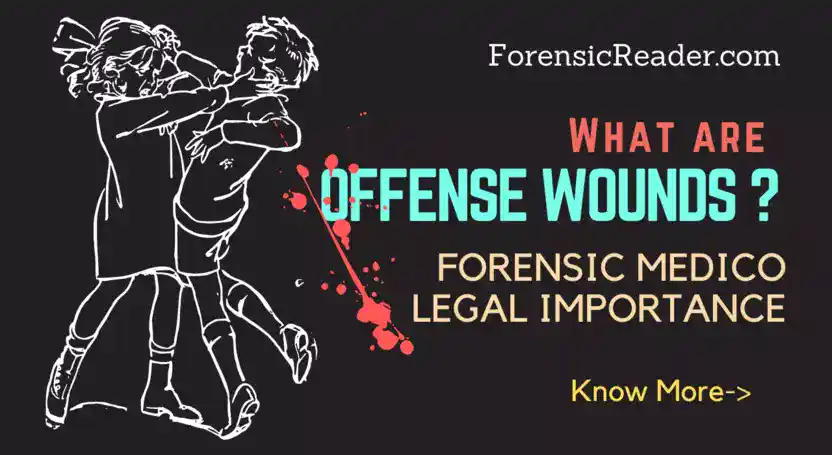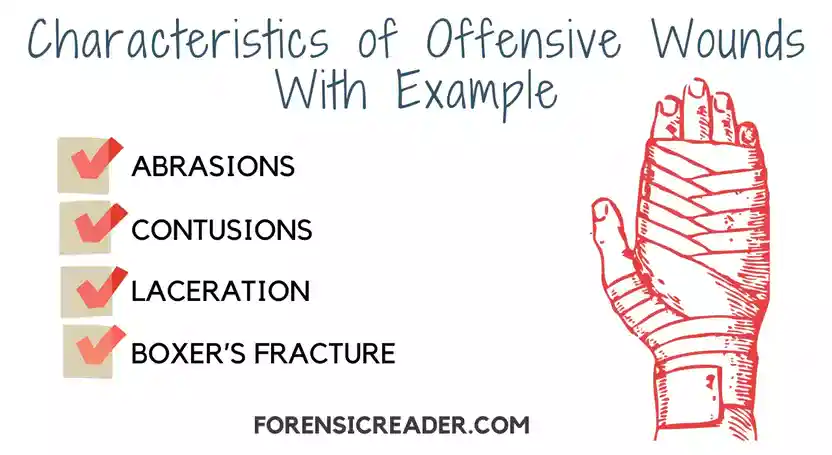Offensive and Defensive wounds are the wounds that could occur during close encounters between the offender and victim. They are likely to be considered as the sides of coins, but here, offensive injuries are rarely seen as compared to defensive wounds.
Forensic Medico-legal Comparison of Defensive Vs Offensive Wound
| Features | Defense Wound | Offense Wound |
|---|---|---|
| Causes | More reflexive than intentional | More intentional than reflexive |
| Mechanism | Victim trying to defend | Victim trying to take charge from assailant or action of assailant. |
| Injuries seen on | Victim | Assailant (mostly), but also on victim |
| Inflected by | Assailant | Majorly by victims with injuries |
| Position of wound | Limbs (mostly upper limbs) | Accessible parts |
| Body parts Involved | Palm, forearm, knuckles | Could be in any part, (knuckles are common) |
| Target part | All sides, even the posterior side (injuries to back & head) | Front and lateral parts of the body |
| Interpretation possibility | Quite easy to interpret | Harder to interpret |
What are Offensive Wounds?

Offensive wounds are just the opposite of the defense wound and are caused when the victim— in order to protect himself/herself— inflicts back injury to the assailant. This primarily happens when the victim gains access to tools that prior used by the attacker over the victim.
The process of obstructing an attacking tool is more intentional than reflexive. But the intention here is not attacking the assailant, but it serves the same purpose as defensive wounds, i.e. to protect themselves.
Defense wounds are more precisely defined as injuries that are more reflexive in nature with no action to give attacker injuries. Here, the reaction or reflection wounds on the victim are seen to protect himself/herself from the assailant.
So whether it is an offense or defense wound, the goal of the victim is to protect himself or herself. But in an offense wound, the person tries to incapacitate the attacker which is, of course, not fully reflexive.
Other names of Offensive Injuries
Other names of offense wounds are:
- Protective wounds
- Injuries simulating defense wounds
Also Read:
- Forensic Analysis of Diatoms in Drowning: Extraction and Procedure
- Paltauf Hemorrhage: Causes, Symptoms [Forensic Medicine]
- Age Estimation From Teeth: All Forensic Odontology Tables Included
Characteristics of Offensive Wounds With Example

The following are the characteristics of offense wounds:
Abrasions in Offense Wounds
Abrasion is the removal of the superficial epithelial layer of the skin.
They are characteristically defined as the removal of epidermis and papillary dermis layers of the skin that are caused by friction to the rough surface.
Following are the common abrasion that is seen in offense injuries:
- Scratch/linear abrasion
- Graze abrasion
- Imprint abrasion
- Friction abrasion
- Bite may tear or crush, resulting in two U-shaped marks
Non-common abrasions are: brush burn abrasions (violently rubbed against the rough surface)
Example: In order to save from assailants, a woman forces assailants away which leads to abrasion on the palmar surface of her hands.
This abrasion was produced when the assailant, to protect himself from falling, puts his hands toward the rough surface. However, if the person falls on the slant surface and rolls, there is also a possibility of getting frictional abrasion due to clothing.
Contusions in Offensive Injuries
They are produced from blunt force trauma that results in the effusion of blood into the underneath subcutaneous tissue of the skin due to the rupture of the blood vessels. Contusions are also called to be bruises.
- Common types of bruises are:
- Intradermal bruise: lies in subepidermal layer
- Subcutaneous bruise: in subcutaneous tissues
- Non-common bruise (very common, if the face is involved)
- Deep bruise: Bleeding deeper to the subcutaneous tissues
Example: The victim somehow gained access to blunt objects from the hand of the assailant and hammered them to the face of that person.
In this case, even a little force of impact may lead to the development of large bruises. In such cases, it becomes harder to interpret who is the assailant and who is the victim.
Laceration in Offense Wound
A laceration is the tearing, splitting, or rupturing of skin, mucous membranes, muscles, or internal organs caused by the application of blunt force to the body when tissues are stretched beyond their elasticity limit.
The most common offense injury is lacerations over the knuckles.
Example: If the assailants punched a fist over the victim’s face whose teeth were exposed. In that case,
- Ragged knuckle laceration wounds (here an offense injury) on the hands of the assailant can be seen because of the exposed teeth (majorly due to anterior teeth).
- Fracture or dislocation of the teeth of the victim. Usually to the 4th and 5th metacarpals (knuckle fracture).
Boxer’s Fracture in Offensive Injury
These fractures are quite common in close-fight. In this, a fracture to the 5th metacarpal bone when the person hits his/her fist against a firm surface.
They are rarely seen in the offense wounds. But the possibility is quite high when the assailant is female.
Boxer fracture, in offensive wounds, majorly occurs when the assailant hits the hard surface of the body such as the head, folded joints, etc.
Medico-legal Importance of Offense Injury/Wound
- An offense wound could be the key to defining a link among victims, assailants, and the crime scene.
- Types of injuries, fractures, or traces of biological material on assailants could be helpful in indicating his/her involvement in the assault. This governs by Locard’s exchange principle.
Why Offense Wounds are Harder to Interpret?

Forensically, an offensive wound is harder to interpret because it could be a case of assault done by a victim himself and framed the real victim as an assaulter by assaulting the real victim and then self-infecting himself/herself.
Example:
Let’s say, person ‘A’ assaulted and cause grievous hurt to victim ‘B’. After that, person ‘A’ self-inflict some injuries to herself to the accessible body parts. And later, filed a complaint against person “B” for an attempt to murder and stated he/she made some injuries to person ‘B’ to defend himself/herself.
So, as a forensic examiner, either these injuries can be categorized as a wound of offense or defense based on the closing interpretation and by knowing the back history of the two.
Hence, it is necessary to have a close look at the case history of the offender and victim.
General FAQ
What is the difference between offense and defense?
Offense wounds are the opposite of defense wounds and are generally seen on the assailant. They are caused either when the victim tries to take charge or the self-wounding action of the assailant. On the other hand, defense wounds are the reaction or reflection wounds on the victim to protect himself/herself from the assailant.
What are the common characteristics of offensive wounds?
The common characteristics of offensive wounds are contusions, abrasions, laceration over knuckles, and boxer injuries.
Laceration over knuckles is majorly seen in offense or defense wounds?
Laceration over knuckles of the hands of the assailant is commonly seen in offense wounds. However, it could also be seen on the hands of the victim while he tries to punch the assailant or as a defense wound when try to protect himself/herself from the blunt force trauma.
Reference:
- Essentials of Forensic Medicine and Toxicology by Anil Aggrawal [Book]
- Additional Work Performed During the Years 1997 to 2000…. by Elizabeth K. Balraj [Csuohio.edu]
- 6 Best Forensic Medicine And Toxicology Books: Review & Comparison

FR Author Group at ForensicReader is a team of Forensic experts and scholars having B.Sc, M.Sc, or Doctorate( Ph.D.) degrees in Forensic Science. We published on topics on fingerprints, questioned documents, forensic medicine, toxicology, physical evidence, and related case studies. Know More.
